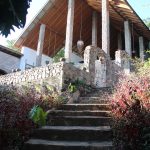Namibia
The land before time
Fun facts
- The Etosha Salt Pan in the Etosha National Park is so large it can be seen from space.
- Namibia is the driest country in sub-Saharan Africa.
- The Namib Desert, where Namibia derives its name from, is the oldest desert in the world.
- Part of The Succulent Karoo—an ecoregion with approximately 10% of the world’s succulents—is found in Namibia.
- Dystopian Oscar-winning movie, Mad Max: Fury Road was shot in the Namib Desert.
CHOOSE YOUR OWN ADVENTURE
- Check out the Namib Desert bike tours.
- Leap out of a plane and go skydiving in Swakopmund.
- Go windsurfing in Walvis Bay.
- Learn about the Damara and the Himba people and see how they live.
- Relax on the beaches along the coast.
Some might know it as the land of endless horizons, but officially this southwestern African country is known as the Republic of Namibia. It was once colonised by Germany and you can see the European influence in its city planning and architecture.
The country has a lot to offer the seasoned traveller and even the novice adventurer. From scenic, relaxing beaches to adrenaline-fuelled quad bike desert rides; metropolitan cafes to ancient rock art; Namibia makes a great destination almost all year round. You can get around by train or bus, but that might not be an adventure all are prepared for. Hiring a car or driving your own is fairly easy, and if you would like to travel very long distances there are flights from the capital city and other towns.
Do note that though the weather is usually hot, it can get cold in the early mornings and evenings, especially during winter, so carry some warm clothing.
THE NAMIB-NAUKLUFT NATIONAL PARK
The Namib-Naukluft is the largest conservation area in Africa and home to Namibia’s most spectacular attraction—Sossusvlei. Sossusvlei is a massive white, salt, and clay pan and its name literally translates to “dead-end marsh.” Its red, jaw-dropping sand dunes are some of the world’s tallest and they can tower up to about 200 metres. The best time to see the dunes is at dawn, where the rising sun creates amazing shades of orange across the vast sands. This scene just might cause you to shed a tear.

The tallest dune in Sossusvlei, Big Daddy, is approximately 325 metres high and is near a white clay pan known as Deadvlei. There you can see dead trees that were scorched by the sun and yet still stand today. These ghosts of nature are about 900 years old and have literally borne witness to the shifting sands of time. The largest dune in the entire Namib Desert is Dune 7, reaching a height of 383 metres.
When the rain is exceptionally heavy, the Tsauchab River fills the pan and creates a marvelous sight. The pan can hold water for even up to a year and despite the harsh desert conditions in the area, one can see numerous plants and animals that have adapted to environment.
In the eastern part of the park, you will find the Naukluft Mountains. Thismight be one of the most peaceful places on earth. Privately owned farms occupy the northern mountains and they are known for leopards and mountain zebras.
WINDHOEK
Namibia’s capital city is a great place to taste authentic Namibian street food, as well as gourmet meals in fine-dining restaurants. Here you can experience the nightlife when the stars come out in the evening, and also shop for gifts and souvenirs in the morning at the various curios markets around the city.

If you’re curious about architecture, the Christuskirche, or Christ Church, is an unmissable site. Built from local sandstone and inspired by both the ornamental art nouveau and neo-gothic architectural styles, this German Lutheran church is a popular landmark in the capital city. It is a well-maintained remnant from Germany’s occupation of the country and was constructed in 1907. It’s said to be the unofficial symbol of Windhoek.
No trip is complete without learning a little about a country’s history. The National Museum of Namibia is a great place to learn about its people—some of who have occupied the same land since prehistoric times—as well as Namibia’s struggle for independence. It is housed in Windhoek’s oldest surviving building and also has a restaurant on its sixth floor. The museum is separated into two display centres: the Owela Museum and the Alte Feste Museum. Elements of Namibian natural history and Namibian ethnography can be found in the Owela, and the Alte Feste contains exhibits on Namibia’s colonial and more recent history. There is no charge to view the exhibits.
SKELETON COAST
The Benguela Current collides with the hot dry air of the Namib Desert over the waters of the Atlantic Ocean and morphs into a thick, rolling fog. For many years this was the dread and demise of many seafarers, causing countless ships to end up on the coast and earning it the name, the Skeleton Coast. You can see the remains of these ships, as well as bones of beached whales and seals along the spooky coast. While this can be a little eerie, it is also a good reminder of the chaotic and yet beautiful nature of life.

Elephants and desert lions occasionally visit the coast too. The Cape Cross Seal Reserve is also along the Skeleton Coast and is the largest colony of cape fur seals on the African coast. Thousands of these ‘dogs of the ocean’ can be seen on the beach and in the water looking for abundant fish and shrimp brought by the Benguela Current, and even seagulls form part of their diet. These seals are endemic to southern Africa and quite a sight to see in their natural element. You might want to carry a face mask as the smell of seal droppings and fish can get a little overwhelming at times.
The views at Sandwich Harbour are nothing short of amazing with its large sand dunes dipping into the ocean and spectacular waves roaring to life. The harbour is part of Dorob National Park and is a birdwatchers dream, with plenty of flamingos, plovers and cormorants—to name a few—feeding on the ample schools of fish.
TWYFELFONTEIN
Once the site of worship and shamanist rituals, the Twyfelfontein is Namibia’s first World Heritage Site with UNESCO calling it “a coherent, extensive and high quality record of ritual practices relating to hunter-gather communities … over at least two millennia.” It is located in the Kunene Region and is home to about 2,500 pieces of rock carvings and some rock paintings. Sandstone outcrops served as canvases for some of the best-preserved engravings on the continent, and one can clearly see depictions of animals like rhinos, giraffes and elephants, as well as humans and geometric art. The oldest engravings are said to be approximately 10,000 years old. The people that called this place home used red ochre for some of their paintings and it serves as a historical record of ancient African art.

The Damara people, descendants of the creators of some of the artworks, still live close to Twyfelfontein and the Living Museum of Damara would make a great stop for those interested in learning about old Namibian culture. Though the museum is an attempt to recreate the lost ways of the hunter-gatherers, it is the most authentic experience of the Damara people one can gain.
An area of open veld in Twyfelfontein known as The Petrified Forest, has about 50 tree trunks frozen in time and they are estimated to be around 260 million years old. They measure up to 34 metres long and 6 metres in circumference and should definitely be part of your itinerary.
ETOSHA NATIONAL PARK
Said to be one of the world’s great wildlife viewing venues, the Etosha National Park is so easily accessible and almost guarantees unique sightings. One might assume that this mostly dry land would not make for great game viewing, but the numerous waterholes around the park attract a variety of animals including springbok, lions, wildebeest, giraffes and even the endangered black rhino. It is also home to the kori bustard, which is the largest flying bird from Africa. But that’s not the only bird you will see. Flamingos and yellow-billed hornbills are a common sight, as are white-backed vultures, marabous and many others.

The national park offers numerous lodging and camping options that suit a range of budgets.



